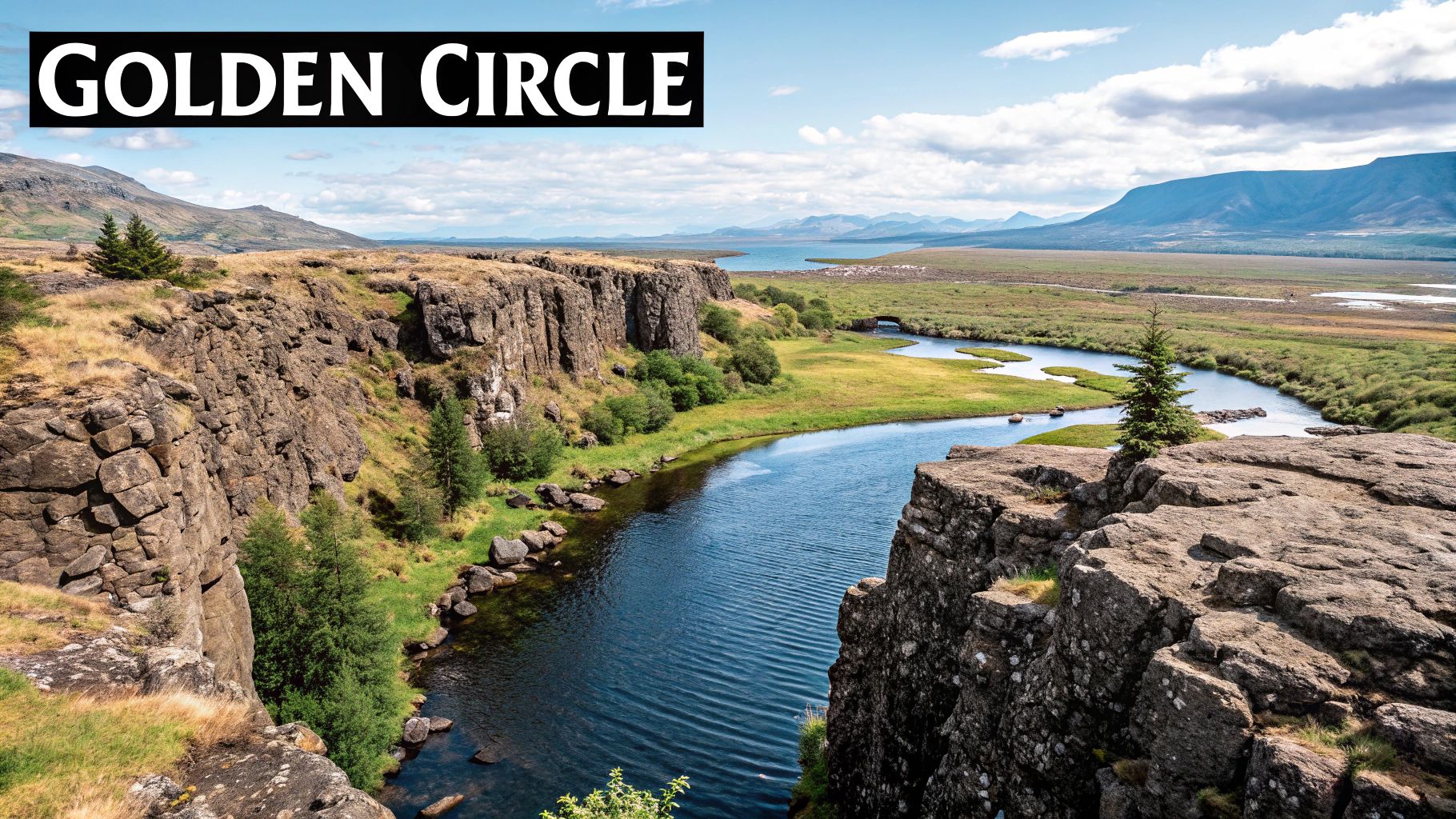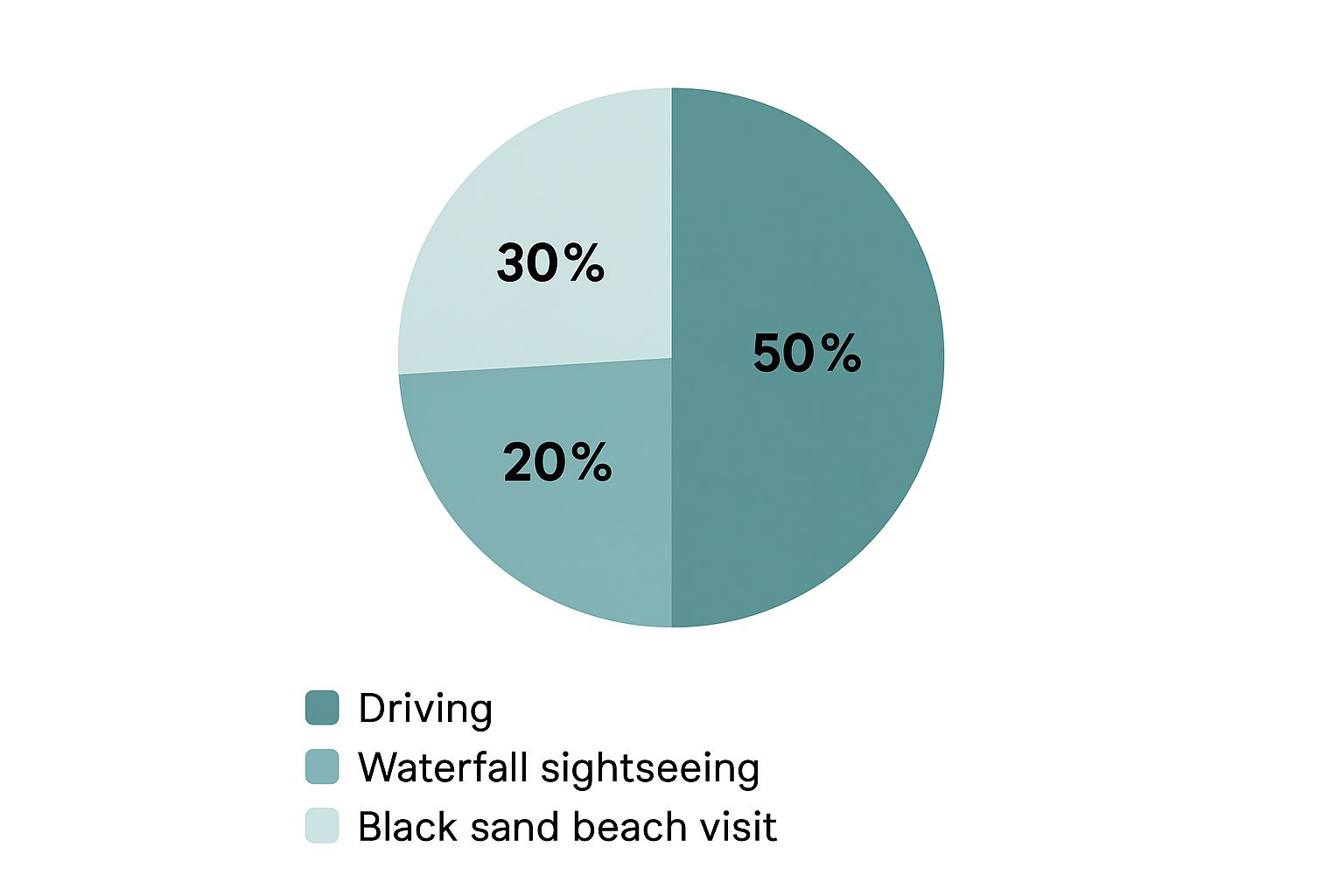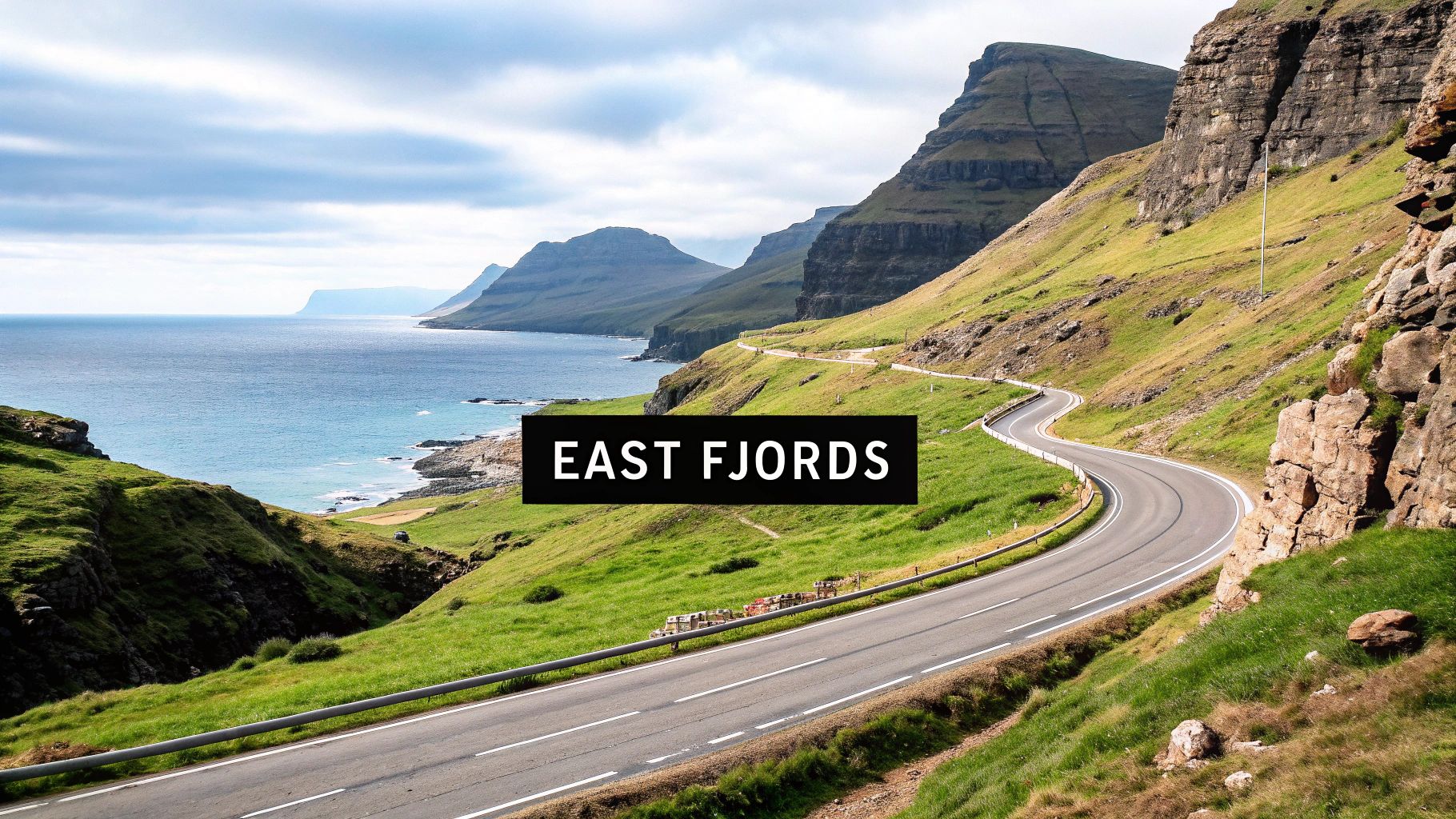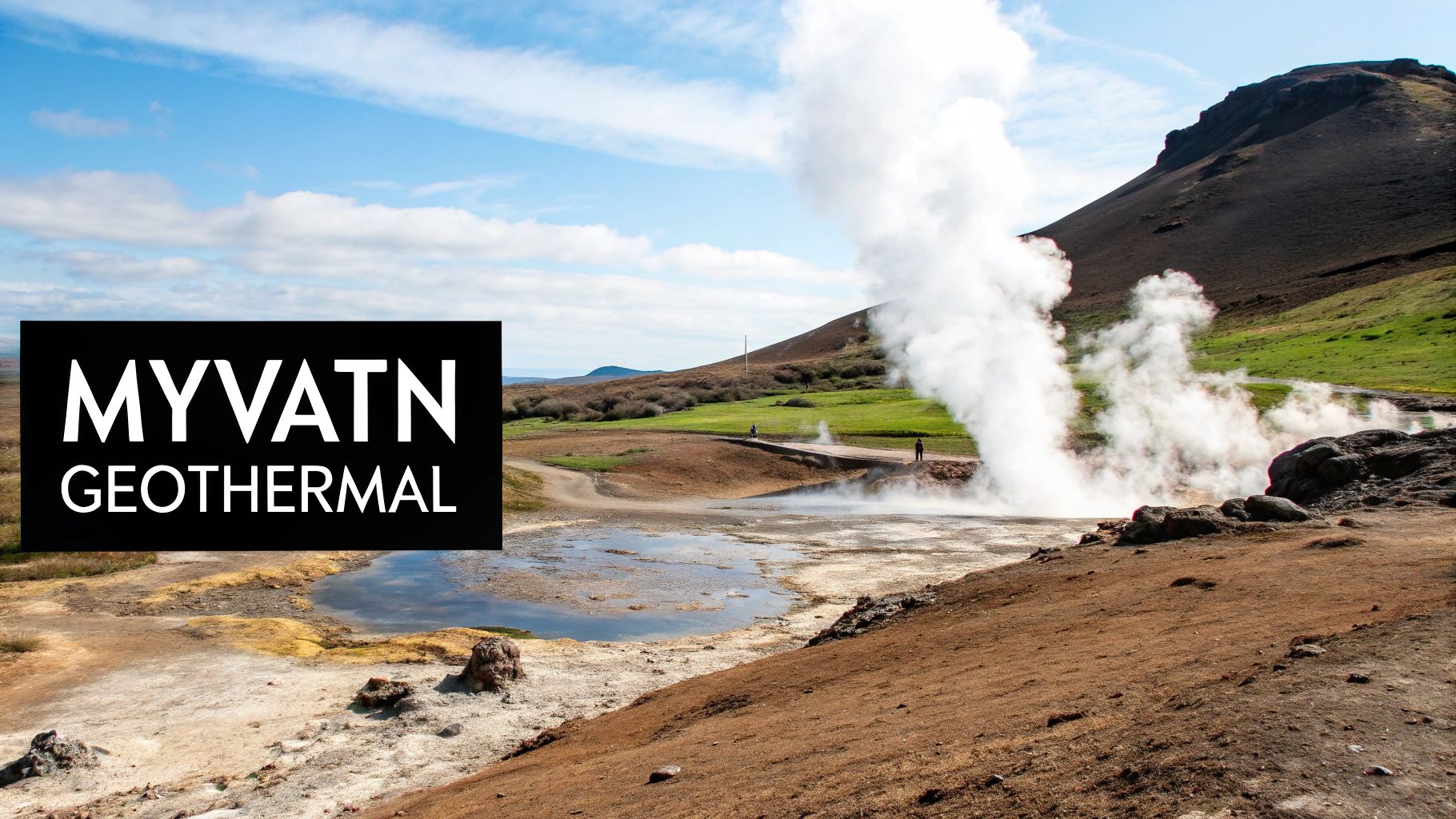
Iceland Ring Road Itinerary 7 Days | Epic Travel Guide
Share
Mastering Your 7-Day Ring Road Adventure

Planning a complete Iceland Ring Road itinerary in just 7 days is ambitious, but definitely doable. The key is finding the right balance between covering the distance and truly experiencing the magic of Iceland. This section will give you the essentials to turn this exciting journey into a well-organized adventure.
Timing Your Adventure
Choosing the right season is vital for the best Ring Road experience. Summer offers nearly constant daylight, allowing for extended sightseeing and those perfect golden hour photos. Be aware, though, this also means larger crowds and increased prices. Winter brings the enchanting Northern Lights and the chance to explore ice caves. However, daylight hours are shorter, and road closures due to snow are a possibility.
Choosing the Right Vehicle
Your vehicle choice is crucial for navigating Iceland's diverse terrain. While a compact car may seem budget-friendly, it could limit your access to the more remote F-roads. These often lead to some of Iceland's most stunning hidden gems. A 4x4 vehicle gives you more flexibility and peace of mind, especially with unpredictable weather. This lets you confidently explore those off-the-beaten-path locations. For some travel inspiration, check out Iceland's Top Attractions: A Guide From Travelers Who've Been 8 Times.
Budgeting and Daily Distances
Iceland's Ring Road, officially Route 1, is approximately 1,322 kilometers (about 820 miles) long, forming a loop around the island. A typical 7-day itinerary involves driving about 190 kilometers per day on average. However, your daily driving distances will likely vary depending on your planned stops and how much time you dedicate to each sight. A realistic budget is essential. Include fuel, accommodation, food, and activities in your calculations. Prices in Iceland are generally higher than in many other countries, so plan accordingly.
Embracing the Unexpected
Icelandic weather is known for its unpredictable nature, making flexibility a necessity. Be ready to adapt your itinerary based on weather conditions. A sudden storm could lead to a change of plans or a longer stay in a particular spot. This adaptability, however, often leads to unexpected discoveries, adding to the adventure. Building in buffer time is a great strategy, just like adding buffer time to project deadlines. It provides a cushion for unforeseen circumstances.
Days 1-2: Southern Wonders From Reykjavik to Vik
Your Iceland Ring Road adventure starts in Reykjavik, but you'll quickly find yourself exploring the countryside. These first two days are essential for setting the tone of your 7-day Ring Road journey. They offer a glimpse of Iceland's iconic landscapes and introduce you to the rhythm of life on the road.
Golden Circle Gems: Thingvellir, Geysir, and Gullfoss
Day 1 centers around the Golden Circle, home to three of Iceland's most famous attractions: Thingvellir National Park, the Geysir Geothermal Area, and Gullfoss waterfall. Thingvellir is geologically significant, situated on the Mid-Atlantic Ridge which separates the North American and Eurasian tectonic plates. It also holds historical importance as the site of Iceland's ancient parliament. Geysir, featuring the Strokkur geyser, offers a mesmerizing display of geothermal activity. Finally, the powerful Gullfoss waterfall is a truly stunning sight. Visiting these locations an hour or two before or after peak times can greatly improve your experience, making crowded areas feel much more peaceful.
South Coast Serenity: Seljalandsfoss and Skógafoss
Day 2 takes you along the scenic South Coast, where you'll discover the hidden beauty of Seljalandsfoss waterfall and the perfect spots to photograph Skógafoss. Many admire Seljalandsfoss from the front, but walking behind the cascading water offers a truly unique perspective. At Skógafoss, consider climbing to the top for panoramic views, a perspective often missed by those admiring it from below. Timing is key for these visits; early morning or late evening offers optimal lighting and fewer crowds, a tip often shared by photographers.
To help you visualize how your time will be allocated on Day 2 of your Ring Road trip, take a look at the following pie chart:

As the chart illustrates, driving takes up a significant portion of the day, emphasizing the importance of planning your sightseeing time effectively. Visiting waterfalls and exploring black sand beaches, such as Reynisfjara with its basalt columns and powerful waves, make up a good portion of the day's activities. This balance between driving and exploration creates a fulfilling journey along the South Coast.
The following table provides a quick overview of the highlights for the first two days:
South Coast Highlights - Days 1-2 Key attractions, driving distances, and recommended time at each location for your first two days on the Ring Road.
| Attraction | Distance from Previous Stop | Recommended Time | Best Time to Visit |
|---|---|---|---|
| Thingvellir National Park | (From Reykjavik) ~45km | 2-3 hours | Early morning/late afternoon |
| Geysir Geothermal Area | ~60km | 1-2 hours | Early morning/late afternoon |
| Gullfoss Waterfall | ~10km | 1-2 hours | Early morning/late afternoon |
| Seljalandsfoss Waterfall | ~100km | 1-2 hours | Early morning/late evening |
| Skógafoss Waterfall | ~30km | 1-2 hours | Early morning/late evening |
| Reynisfjara Black Sand Beach | ~30km | 1-2 hours | Anytime, but be cautious of sneaker waves |
| Vik i Myrdal | ~20km | Overnight | - |
This table provides estimated distances and times to help you plan your journey. Remember that these are suggestions and can be adjusted based on your interests.
Finding Your Base in Vik
Choosing accommodation in Vik isn't just about comfort and budget; it's a strategic decision that impacts the next stage of your journey. Consider its proximity to your planned activities for Day 3. Thinking ahead can significantly minimize driving time and maximize your exploration opportunities. Vik also offers a chance to experience Icelandic hospitality in a charming coastal village. For those seeking authentic local experiences, explore the village's unique shops and restaurants, relax on the black sand beaches, or simply enjoy the atmosphere of this picturesque South Coast hub. A well-planned itinerary and strategic accommodation choices are vital for a successful Iceland Ring Road adventure.
Days 3-4: Glacier Wonderlands of Southeast Iceland

Prepare to be captivated by Southeast Iceland's breathtaking scenery. Here, massive glaciers meet black sand beaches, creating a truly surreal landscape. This part of your 7-day Iceland Ring Road itinerary focuses on exploring Vatnajökull National Park, the largest national park in Europe. It's a region brimming with opportunities to go beyond the typical tourist attractions and experience the raw beauty of Iceland's glaciers.
Exploring Vatnajökull: Beyond the Viewpoints
Vatnajökull National Park offers a network of trails for immersive exploration. Local guides can be a valuable resource, leading you to hidden gems and less-traveled paths that showcase the park's diverse beauty. Imagine hiking to a secluded waterfall or embarking on a guided glacier walk for panoramic views. These guided experiences offer insights into the glacier's formation and the effects of climate change.
Jökulsárlón Glacier Lagoon: Timing is Everything
The stunning Jökulsárlón Glacier Lagoon is a must-see. However, the timing of your visit can greatly impact your experience. The lagoon's appearance transforms throughout the day as the light changes, casting different colors on the icebergs. Visiting during sunrise or sunset offers a magical display of light and reflections. Don't miss Diamond Beach, where icebergs wash ashore onto the black sand, creating a striking visual contrast and fantastic photo opportunities.
Glacier Tours and Ice Cave Adventures
A variety of glacier tours are available, from larger boat tours to more intimate ice cave explorations. Understanding the differences will help you choose the best fit for your Ring Road trip and budget. Commercial tours offer a convenient overview, while ice cave tours provide an up-close encounter with these natural wonders. Consider group size, duration, and physical requirements when selecting a tour. Each option has its own advantages depending on your preferences.
Safety First in Glacial Landscapes
Glacial landscapes, while beautiful, require specific safety precautions. Speaking with adventure guides can provide essential safety tips for navigating these powerful environments. Be mindful of crevasses on glaciers and sneaker waves on black sand beaches. Respecting the power of nature and following expert advice will allow you to enjoy these magnificent landscapes safely.
Weather in glacial areas can change quickly. Pack layers of warm clothing, waterproof gear, and sturdy hiking boots. Regularly checking the weather forecast and being prepared for changes is crucial. Iceland's tourism sector has seen significant growth, driven in part by the Ring Road's popularity. Before the pandemic, Iceland welcomed over 2 million international visitors annually, a notable figure for a country with a population of around 370,000. The Ring Road serves as a backbone for tourism, with an estimated 70% of tourists renting vehicles to explore this scenic route. More detailed statistics can be found here. This emphasizes the importance of planning your 7-day Ring Road itinerary carefully.
Culinary Adventures in Höfn
Höfn, located in Southeast Iceland, is renowned for its langoustine. However, this region offers much more for culinary explorers. Venture beyond the typical tourist restaurants and try authentic Icelandic dishes like plokkfiskur (fish stew) or skyr (a traditional Icelandic dairy product). Experiencing the local cuisine adds another dimension to your Ring Road adventure. Savor the fresh seafood and connect with the local community through its culinary traditions.
Day 5: Eastern Fjords to North Iceland Transition
This leg of your 7-day Iceland Ring Road itinerary ventures through a region often bypassed by travelers hurrying north. Yet, Eastern Iceland possesses a distinct charm, offering a glimpse into a side of Iceland less affected by large numbers of tourists. Today focuses on enjoying the journey, with breathtaking fjord vistas and hidden gems waiting to be discovered.
Exploring the Eastern Fjords: Untouched Beauty
The Eastern Fjords showcase Iceland's raw, natural beauty. Winding roads embrace the coastline, unveiling dramatic cliffs descending into the ocean and charming fishing villages nestled in secluded coves. This area provides a chance to decelerate, connect with the local culture, and embrace the tranquility of Iceland's less-traveled routes.
It's a place where you can genuinely escape the crowds and immerse yourself in the serenity of the fjords. The landscape unfolds before you, offering an intimate connection with the natural world. You'll find a rhythm that's different from the rest of your journey, a slower pace that allows for true appreciation.
Wildlife Encounters: Spotting Wild Reindeer
Eastern Iceland is the only part of the country where you might spot wild reindeer. These magnificent animals wander freely, often seen grazing near the roadside. Stay observant as you drive – glimpsing a herd against the backdrop of the fjords is a remarkable experience.
For wildlife enthusiasts, this area offers an unparalleled opportunity to observe these animals in their natural habitat. It adds a unique element to your Ring Road adventure, a chance encounter that makes your trip even more special.
Village Visits: Experiencing Icelandic Hospitality
The small fishing villages dotted along the Eastern Fjords provide insight into authentic Icelandic life. Stop in these villages to browse local shops, enjoy a meal at a family-run restaurant, or simply converse with the welcoming residents.
These interactions create memorable moments and provide a genuine connection with Icelandic culture. It's here you'll encounter the warmth of Icelandic hospitality, a hallmark of any trip to this extraordinary island nation. You'll find the locals eager to share their stories and experiences, enriching your journey.
Managing Longer Driving Distances: Strategic Stops
This portion of your Iceland Ring Road itinerary entails a longer drive, possibly 250-300 km. To avoid feeling rushed, plan strategic stops en route. Consider a short hike to a scenic overlook, a picnic lunch by a fjord, or exploring a hidden waterfall.
These breaks not only divide the driving time but also allow you to fully appreciate the diverse landscapes revealed along the Ring Road. They transform the journey itself into an integral part of the adventure, adding to the overall experience.
Dettifoss: Witnessing Europe's Most Powerful Waterfall
The pinnacle of this day is Dettifoss, Europe's most powerful waterfall. The sheer force of the water plunging over the cliff is a breathtaking spectacle. While both sides of the falls offer viewing platforms, the east side typically provides a more dramatic vista.
Even novice photographers can capture the raw power of Dettifoss with basic techniques. Try experimenting with various shutter speeds to convey the water's movement or use a wide-angle lens to capture the immensity of the falls within the encompassing landscape. This natural wonder serves as a fitting culmination to a day exploring Eastern Iceland's hidden treasures. Your next adventure awaits as you continue to North Iceland, pursuing your 7-day Ring Road exploration.
Days 6-7: Northern Geothermal Wonders to Reykjavik

As your 7-day Iceland Ring Road adventure draws to a close, prepare for another shift in scenery. These final days focus on maximizing your time, offering alternatives to busy tourist spots and smart strategies for finishing your Ring Road journey strong. The geothermal marvels of North Iceland offer a truly distinctive experience, a stark contrast to the icy landscapes of the south.
Exploring Lake Mývatn: Geothermal Landscapes
Lake Mývatn provides a unique window into Iceland's geothermal activity. Bubbling mud pots and steaming vents create an almost surreal scene, often likened to a Martian landscape. The area surrounding the lake is dotted with unusual geological formations, a testament to Iceland's volcanic history.
Explore the Dimmuborgir lava formations, otherworldly pillars of solidified lava. Hike to Hverir, a vibrant geothermal area with bubbling mud pots and fumaroles. Witness the raw geothermal power of the Krafla volcano, a still-active volcano that last erupted in 1984.
Mývatn Nature Baths: A Relaxing Alternative
Searching for a less crowded alternative to the famous Blue Lagoon? The Mývatn Nature Baths offer a comparable experience. Enjoy the same milky blue, mineral-rich waters, with fewer crowds and equally stunning views. Imagine soaking in the warmth, enveloped by the serene beauty of North Iceland. This is the ultimate tranquil retreat. Reflect on your incredible journey along the Ring Road.
Akureyri: The Capital of the North
Akureyri, fondly known as the "Capital of the North," is a bustling hub with a thriving cultural heart. Discover why the locals love this city, through conversations and experiences that truly reflect Northern Icelandic life.
Visit the Akureyri Botanical Garden, a surprisingly lush collection of plants given the northerly latitude. Explore the town's charming shops and cozy cafés. Simply enjoy the atmosphere of this dynamic town, a refreshing taste of Icelandic urban life beyond Reykjavik.
Completing the Circle: Strategic Choices
As you get ready to head back to Reykjavik, some key decisions await. Do you return directly to the capital? Or take a detour through the Snæfellsnes Peninsula, often called "Iceland in Miniature"?
This peninsula packs in a concentration of Iceland's iconic features: dramatic cliffs, black sand beaches, and the famous Kirkjufell mountain. It's a trade-off: experiencing more of Iceland's diversity versus a more relaxed return to Reykjavik.
Final Days Logistics: Practical Guidance
The last leg of your 7-day Iceland Ring Road itinerary requires some practical planning. Arrange your vehicle return and book your final night's accommodations. Consider seeking out authentic Reykjavik experiences. These details ensure a smooth end to your trip.
Reykjavik: Celebrating Your Journey
Back in Reykjavik, celebrate your successful Ring Road adventure. Explore local restaurants. Visit fascinating museums. Enjoy the city's energetic nightlife. Perhaps a farewell dinner featuring traditional Icelandic cuisine? A perfect ending to an unforgettable trip.
North & West Iceland Highlights - Days 6-7
To help you plan, here's a summary of key stops and estimated driving times:
| Location | Key Attractions | Driving Time | Worth Stopping? |
|---|---|---|---|
| Lake Mývatn | Dimmuborgir, Hverir, Krafla | Varies depending on activities | Definitely |
| Mývatn Nature Baths | Geothermal pools | Allow 2-3 hours | Yes, for a relaxing experience |
| Akureyri | Botanical Garden, local shops and cafes | Explore at your own pace | Recommended |
| Snæfellsnes Peninsula | Kirkjufell Mountain, black sand beaches, dramatic cliffs | Add 1-2 days for a thorough exploration | Consider if you want to see "Iceland in Miniature" |
| Reykjavik | Museums, restaurants, nightlife | Depends on your interests | Essential for your final night |
This table offers a quick overview of potential stops and time estimates. Remember, this is just a suggestion – adjust it based on your interests and available time. The Ring Road’s history adds another dimension to your trip. Construction began in the 1940s, connecting remote communities with Reykjavik and boosting the economy.
By planning strategically, you can conclude your 7-day Iceland Ring Road adventure on a high note. Create lasting memories that capture the true essence of Iceland's varied and breathtaking beauty.
Navigating Iceland's Seasons: When to Drive the Ring
Your seven-day Iceland Ring Road itinerary changes dramatically with the seasons, affecting both road conditions and the sights you'll encounter. Each season provides a unique experience. Understanding these nuances is key to planning your adventure. Let's explore the advantages and challenges of each, incorporating insights from local experts.
Summer Solstice Road Trip: Midnight Sun and Crowds
Summer in Iceland offers the midnight sun, boasting over 20 hours of daylight. This allows you to maximize your sightseeing, truly making the most of your seven-day Ring Road adventure. However, this constant daylight can affect sleep, so remember to pack an eye mask. Summer is also peak tourist season, meaning higher prices and more visitors at popular locations.
Winter's Embrace: Northern Lights and Ice Caves
Winter brings the magical Northern Lights and opportunities to explore breathtaking ice caves. But it also presents its own set of challenges. Daylight hours are significantly reduced, impacting driving time. Winter storms can cause road closures, especially in the mountains. Careful weather monitoring and itinerary flexibility are crucial for a successful winter Ring Road trip. For more planning tips, read: How to plan a trip to Iceland 2025 guide.
Shoulder Season Charm: Fewer Tourists, Favorable Conditions
Late spring and early autumn (the shoulder seasons) offer a balance between pleasant weather and manageable tourist numbers. You'll enjoy reasonable daylight hours and decent road conditions while encountering fewer fellow travelers. This translates to a more relaxed experience and more opportunities to connect with Icelandic culture.
Adapting Your Itinerary: Seasonal Considerations
Smart Ring Road travelers adapt their plans based on the time of year. Some mountain passes are inaccessible in winter because of heavy snow. Knowing these closures beforehand and planning alternative routes is essential. Understanding Iceland's weather forecasting systems – the ones Icelanders rely on – is also crucial for making informed decisions while on the road.
Packing Smart: Seasonal Gear Beyond the Basics
Packing for Iceland requires more than the usual travel advice. In summer, pack light layers, but always include a waterproof outer layer for unexpected rain. Eye masks are essential to block the midnight sun. Winter calls for serious cold-weather gear: thermal underwear, waterproof and insulated outerwear, sturdy hiking boots, gloves, and hats. Consider packing crampons for navigating icy surfaces, particularly during winter excursions.
Ring Road Success: Essential Strategies and Insights
Successfully navigating Iceland's Ring Road in 7 days takes more than just a rental car and a map. It requires careful planning, smart decisions, and a willingness to adapt to Iceland's ever-shifting weather. This section provides insights and practical advice from experienced Ring Road travelers, turning your trip from a potential logistical headache into a seamless, enriching experience.
Vehicle Choice: 4x4 or Budget-Friendly?
Your vehicle choice greatly impacts your Ring Road experience. A 4x4 vehicle provides access to the rugged F-roads, leading to remote highlands and breathtaking views, but it also costs more to rent. Think about your itinerary. If you're mainly sticking to the paved Ring Road (Route 1), a standard 2WD car might be enough, especially in the summer. However, if you're eager to explore beyond the pavement, a 4x4 is a must. Don't spend more than you need on extra features, but prioritize safety and access based on your planned adventures.
Accommodation Strategy: Bookings and Flexibility
Finding a good balance between pre-booked accommodations and on-the-fly changes is important, given Iceland's unpredictable weather. Booking ahead during the peak summer season is highly recommended to secure your top choices. Consider booking accommodations with flexible cancellation policies so you can adjust if weather disrupts your plans. This offers peace of mind while letting you adapt your 7-day Iceland Ring Road itinerary as needed.
Tech Tools for the Savvy Traveler
Using the right technology can make your Ring Road trip even better. Download offline maps and navigation apps for reliable directions, even in areas with limited internet access. Use weather apps that Icelanders trust for up-to-date forecasts and road conditions. This allows you to make informed choices, especially in areas where conditions can change rapidly. Knowing drone regulations is crucial for aerial photography. For more details on drone flight restrictions, check out this resource.
Budgeting for Your Ring Road Adventure
Managing your budget well prevents financial surprises during your trip. Many travelers budget around $1,500 to $2,500 per person for a 7-day Ring Road trip, covering car rental, accommodation, food, and activities. Learn more about budgeting for your trip here. This amount can change depending on your travel style, accommodation choices (luxury hotels versus budget-friendly guesthouses), and dining preferences (restaurants versus self-catering). You might also be interested in photography tips for your trip: How to master Icelandic photography. Making a detailed budget beforehand and tracking your spending during your trip will help you stay within your budget.
Fuel, Food, and Cultural Etiquette
Understanding Icelandic infrastructure will improve your journey. Not all gas stations are open 24/7, so plan your fuel stops, particularly in remote areas. Grocery stores are great for affordable food shopping. Preparing picnics and snacks can help you avoid pricey restaurant meals. This not only saves money but lets you enjoy meals surrounded by Iceland’s stunning scenery. Finally, embracing cultural etiquette improves your interactions with locals. Simple gestures like learning basic Icelandic phrases show respect and create positive connections.
